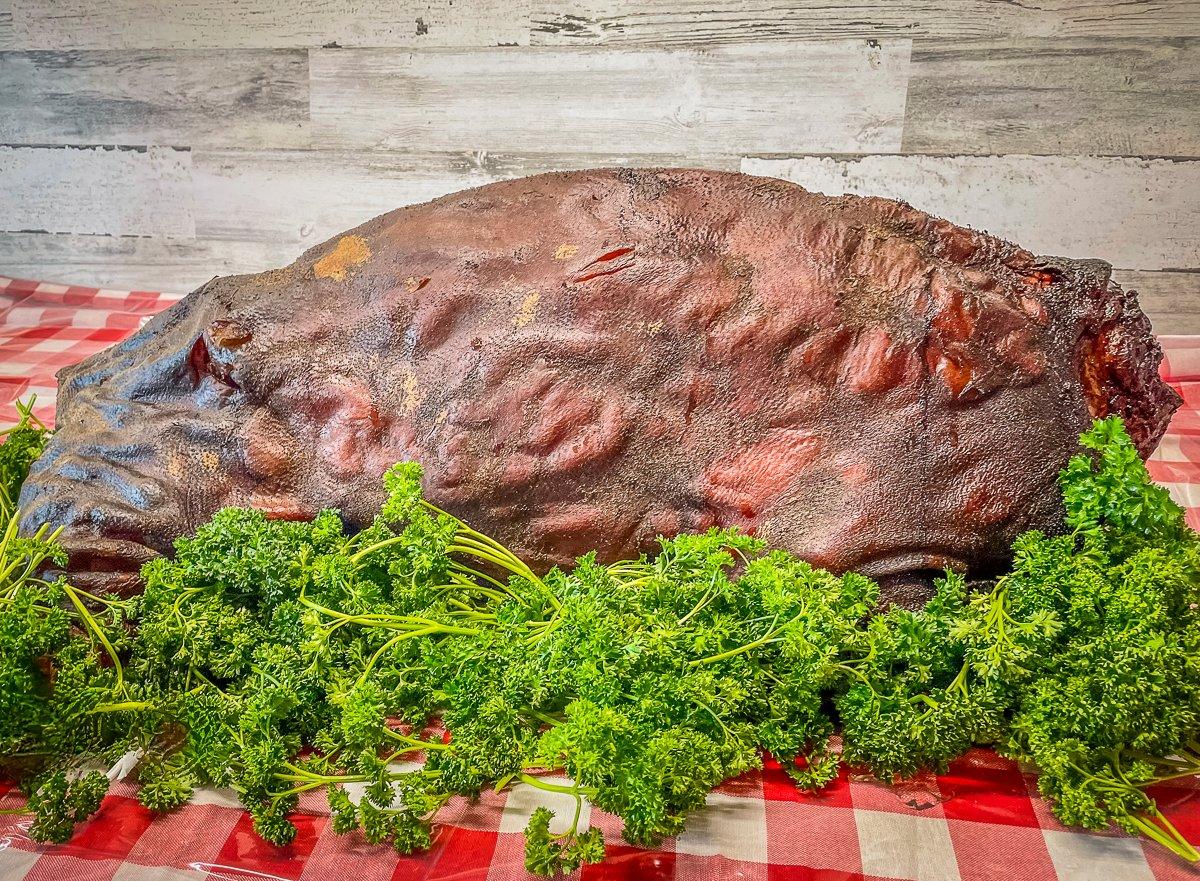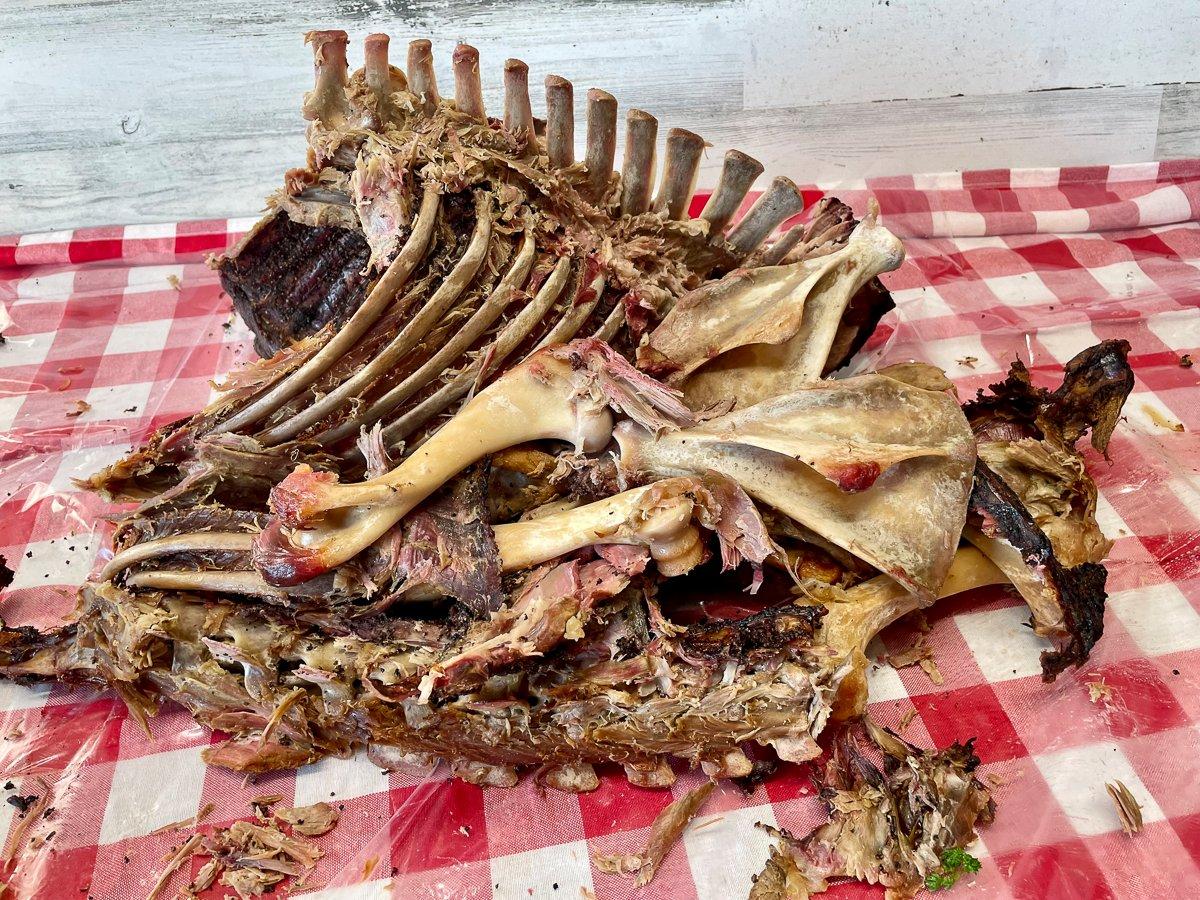With your hog prepped and ready, here's how to cook it low and slow for an unforgettable meal
A plate full of slow smoked, fall-apart-tender pork is the ultimate wild game feast. A good hog roast doesn't need much. Salt, pepper, and hickory or fruit wood smoke will add all the extra flavor the succulent meat requires. An injection of apple cider or peach juice helps to keep the meat juicy as the hog cooks.
You've got a pig on the ground, and have already prepped it for cooking, right? If you missed that step, refer back to Part 1: Scalding and Prepping. It's surprisingly easy.
You can smoke a hog over open coals or on a smoker. All you need is a consistent temperature around 250 degrees, wood smoke, and time.
Don't expect your hog to be finished in a hurry. A good hog roast takes time, often as much as 24 hours, so be prepared.
Regardless of heat source, the cooking method is the same. I like to start the hog belly down for a few hours to get some nice smoke flavor on the inside, then flip it over so the skin (if you are doing your hog skin on) can get crispy and crackly.
A good roasting-sized hog ranges from 40 to 80 pounds, dressed. Obviously, smaller hogs will cook faster, but an 80-pound hog will feed a big crew of folks if you have a lot of friends over for dinner.
I like to start out by injecting apple or peach juice deep into all the muscles of the hog. For this 50-pounder, I used about 2 quarts. If you want to add even more flavor, you can blend a bit of your favorite hot sauce into the fruit juice.
From there, all you really need is salt and pepper, although many veteran roasters like to use their favorite BBQ rub.
Season the open belly area liberally with salt and pepper. By liberally, I mean season it to the point where you think it's enough, then add a bit more. Season the skin side of the hog as it cooks. The oil that comes to the surface of the skin will help hold the seasoning better than the cold skin will.
Open Coals
A true old-fashioned hog roast uses open coals shoveled under the pig continuously as the hog cooks. The downside to this method is that it requires near constant supervision to keep the heat at the perfect level, and you need dry conditions or a roof over your fire pit in case it rains. The upside? The crispiest pork skin and tenderest, tastiest pulled pork barbecue you have ever tasted.
The Pit
A good roasting pit can be as simple as a pile of coals on the ground with four corner rocks, blocks, or posts to elevate your cooking grate above the embers. I like a height of 14 to 20 inches for the cooking surface.
From there, you can get a bit more elaborate with concrete blocks stacked into a rectangle to hold your cooking grate and protect the coals from wind. Be sure to leave a block out on each end of the base for airflow. Continuing with a level or two of blocks above your cooking grate allows you to cover the pig with sheet metal to hold in heat and speed cooking times.
The Wood
When it comes to cooking wood for a hog roast, hickory is king. Other great choices include oak, or fruit woods like peach or cherry. I often blend hickory and fruit wood for extra flavor. Make sure your wood is dry and well seasoned. Green wood, green hickory in particular, can leave a bitter flavor on your pork.
The Fire
Calling it a fire is a bit of a misnomer. You don't want any flames at all, just glowing red coals. To accomplish this, build your main fire outside the pit or away from the pig and let it burn down to coals. Then transfer the coals below the pig with a shovel. Many veteran hog roasters prefer to build their fire in a customized metal drum with an opening at the bottom that allows them to easily shovel coals from the base of the barrel to the pit. Whichever method you use, keep your fire fed with fresh logs so you always have a ready supply of coals.
The Roast
As mentioned, I normally start the hog belly down, skin side up. Shovel an even bed of coals under the entire hog, then add an additional shovelful below both the shoulders and the hams, as the thicker areas need a bit more heat than the belly and loins to finish.
As the coals cook down, replenish them from the fire. Your temperature should be just hot enough to make fat drip slowly from the meat, but not hot enough that you can hear and see the meat sizzle like you would on a high-temperature grill.
After a few hours, secure a buddy for help, don some barbecuing gloves, and grab the hog by the ends of the legs. At the same time, lift the hog from both ends and give it a flip so the skin faces the fire. Continue cooking until the hog reaches about 200 degrees in the thickest part of the hams and shoulders. Covering the hog with a sheet metal top helps hold and reflect the heat to cook the hog from both sides and get the job finished a bit faster.
Smoker
While open coals might be the most traditional way to cook your hog, there is no denying that a smoker is way easier and requires less hands-on care. The type of smoker is up to you, but make sure it's large enough to hold the hog. Big stick burners are the most obvious style, and you can often rent one at a local party supply store if you don't own one, but even a large pellet grill can turn out an excellent hog.
My Traeger Timberline 1300 is the perfect size for a 50- to 60-pound hog, and that is plenty large to feed a crowd. We start the pig the same way, belly down, but this step isn't quite as important on a smoker as it is over open coals. After a few hours, flip the hog to skin side down.
I like to run my Traeger at 225 degrees with the Supersmoke function on for extra smoke flavor. After a few hours, turn the temperature up to 250 degrees to speed the cooking process. Just like the open coals, the pig is ready when a meat thermometer reaches 195 to 200 degrees Fahrenheit in the thickest part of the hams and shoulders.
Serving
Regardless of the roasting method, a whole roasted hog is a thing of beauty and deserves to be shown off. I like to serve ours by spreading a plastic tablecloth over a table and placing the hog, skin up, directly onto the tablecloth. If you really want to get fancy, surround it with some curly parsley, fruit, or other decorations.
To serve, use a knife to crack the skin along the back, hams, and shoulders. The meat should pull easily from the bone. Let your guests choose the type of meat they want, loin, tenderloin, shoulder, hams, belly, or ribs. Or they can get the complete whole hog package with a bit of meat from everywhere. A good set of professional kitchen tongs are handy for pulling meat from the bone. I like to serve the hog with sauce on the side, and I'll often put out a variety of sauces like traditional BBQ, Carolina-style mustard, or Alabama white sauce. A sure sign of a good pig roast is a pile of clean bones left once everyone has eaten.
Leftover meat can be picked from the bone and vacuum sealed for freezing. Simply thaw and reheat (sous vide is great for this) for sandwiches anytime you are in the mood for BBQ.














